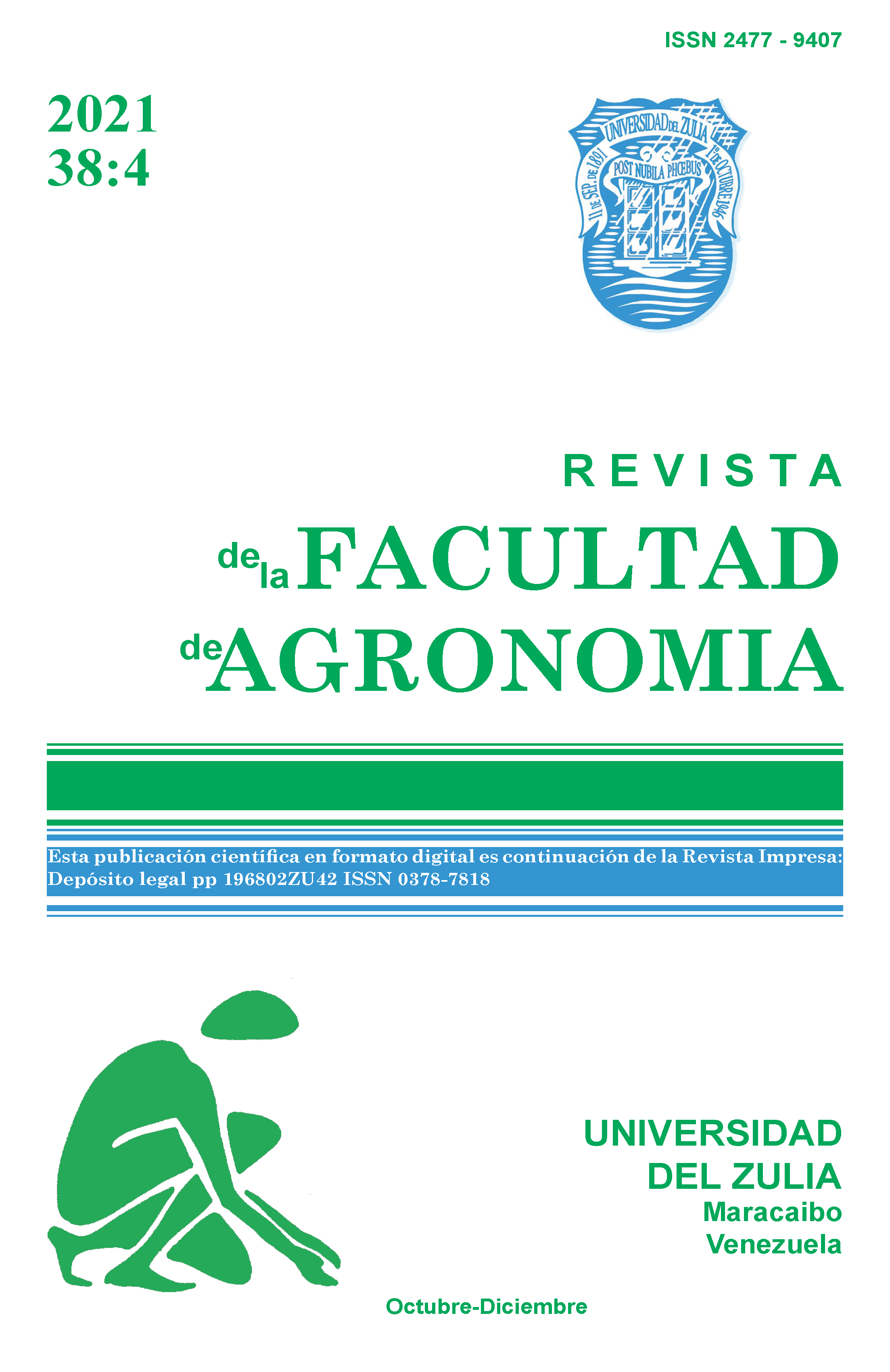Ocimum basilicum L. bactérias associadas com atividade antifúngica
Resumo
A presença de patógenos, como fungos, é uma das causas mais importantes de perda de lavouras de manjericão em todo o mundo; entretanto, muitos microrganismos desempenham um papel crucial no desenvolvimento das plantas, incluindo proteção contra patógenos. No presente estudo, as bactérias associadas ao manjericão predominantes foram isoladas, quantificadas e preservadas. A caracterização das bactérias isoladas mostrou 165 cepas Gram positivas, 152 com morfologia bacilar e 13 com cocóide. Posteriormente, foram realizados testes de antagonismo in vitro, primeiro contra Aspergillus spp. e mais tarde contra Neoscytalidium dimidiatum, Alternaria, spp. e Aspergillus spp. Por fim, foram realizados ensaios para avaliar o efeito das bactérias isoladas na germinação das sementes e nos estágios iniciais do desenvolvimento do manjericão. As plantas de manjericão amostradas, produzidas em torno de La Paz, Baja California Sur, México, foram colonizadas por bactérias antagonistas conhecidas do gênero Bacillus. As cepas de Bacillus amyloliquefaciens foram aquelas que exibiram predominantemente atividade antifúngica. Além disso, as cepas ALMH42, ALMR73 e ALAH91 não apresentaram efeito deletério no desenvolvimento de mudas de manjericão. A exploração do potencial biotecnológico dessas cepas isoladas de plantas saudáveis de manjericão é de grande interesse para futuras aplicações nesta e em outras culturas.
Downloads
Referências
Banchio, E., X. Xie, H.Zhang, and P. W. Paré. 2009. Soil bacteria elevate essential oil accumulation and emissions in sweet basil. J. Agric. Food Chem., 57: 653-657. https://cutt.ly/znRmSq2
Broda, D.M., P.A. Lawson, R.G. Bell and D.R. Musgrave. 1999. Clostridium frigidicarnis sp. nov., a psychrotolerant bacterium associated with ‘blown pack’ spoilage of vacuum-packed meats. Int. J. Syst. Bacteriol., 49: 1539-1550. https://cutt.ly/snRmDTh
Chen, X. H., A. Koumoutsi, R.Scholz, and R. Borriss, 2009. More than anticipated - production of antibiotics and other secondary metabolites by Bacillus amyloliquefaciens FZB42. MIRCEN J. Appl. Microbiol. Biotechnol., 16: 14-24. https://cutt.ly/4nRmHmY
Daungfu, O., S. Youpensuk and S. Lumyong. 2019. Endophytic bacteria isolated from citrus plants for biological control of Citrus Canker in lime plants. Tropical Life Sciences Research, 30: 73-88. https://cutt.ly/nnRmKkq
Gilardi, G., S. Demarchi, A.Garibaldi, and M. L. Gullino, 2013. Management of downy mildew of sweet basil (Ocimum basilicum) caused by Peronospora belbahrii by means of resistance inducers, fungicides, biocontrol agents and natural products. Phytoparasitica, 41: 59-72. https://cutt.ly/4nRmL64
Goldman, E. and L.H. Green (Ed.) 2009. Practical Handbook of Microbiology, Second Edition. 2nd ed. London, pp.3-63. ISBN 978-0-8493-9365-5
Gowtham, H.G., M. Murali, S. B.Singh, T. R. Lakshmeesha, K.Narasimha Murthy, K. N. Amruthesh and S. R. Niranjana. 2018. Plant growth promoting rhizobacteria Bacillus amyloliquefaciens improves plant growth and induces resistance in chilli against anthracnose disease. BIOL CONTROL., 126: 209-217. https://cutt.ly/QnRmC4n
Hernández-Montiel, L.M., T. Rivas-García, M. Romero-Bastidas, C. J. Chiquito-Contreras, F. H. Ruiz-Espinoza and R. G. Chiquito-Contreras. 2018. Potencial antagónico de bacterias y levaduras marinas para el control de hongos fitopatógenos. Rev. Mexicana cienc. agric., 20: 4311-4321. https://cutt.ly/JnRmBDJ
Jacobs, J.L., T. L. Carroll and G. W. Sundin, 2005. The role of pigmentation, ultraviolet radiation tolerance, and leaf colonization strategies in the epiphytic survival of phyllosphere bacteria. Microb. Ecol, 49: 104-113. https://cutt.ly/CnRmN5H
Joo, H.J., H.Y. Kim, L.H. Kim, S.Lee, J.G. Ryu, and T.A. Lee, 2015. Brevibacillus sp. antagonistic to mycotoxigenic Fusarium spp. BIOL CONTROL., 87: 64–70. https://cutt.ly/enRm2fT
Kim, M.J., R. Radhakrishnan, S.M. Kang, Y.H. You, E.J. Jeong, J.G. Kim and I.J. Lee, 2017. Plant growth promoting effect of Bacillus amyloliquefaciens H-2-5 on crop plants and influence on physiological changes in soybean under soil salinity. Physiology and Molecular Biology of Plants, 23: 571-580. https://cutt.ly/TnRm9LI
Liu, Z., A. Budiharjo, P. Wang, H. Shi, J. Fang, R. Borriss, K. Zhang, and X. Huang, 2013. The highly modified microcin peptide plantazolicin is associated with nematicidal activity of Bacillus amyloliquefaciens FZB42. Applied Microbiology and Biotechnology, 97: 10081-10090. https://cutt.ly/bnRm8th
Lugtenberg, B. and F. Kamilova. 2005. Plant-growth-promoting rhizobacteria. Annu. Rev. Microbiol., 63, 541-556. https://cutt.ly/jnRm40B
Moffat, A.S. 2001. Finding new ways to fight plant diseases. Science, 292: 2270-2273. https://cutt.ly/nnRm6p0
Pieterse, C. M. J., C. Zamioudis, R. L. Berendsen, D. M. Weller, S. C. M. Van Wees and P. A. H. M. Bakker. 2014. Induced systemic resistance by beneficial microbes. Annu Rev Phytopathol, 52: 347-375. https://cutt.ly/DnRQqHm
Pound, M., A. French, J. Atkinson, D. Wells, M. Bennett and T. Pridmore, 2013. RootNav: Navigating Images of Complex Root Architectures. Plant Physiology, 162: 1802-1814. https://cutt.ly/snRQeXx
Purahong, W., L. Orrù, I. Donati, G. Perpetuini, A. Cellini, A. Lamontanara, V. Michelotti, G. Tacconi, and F. Spinelli. 2018. Plant microbiome and its link to plant health: host species, organs, and Pseudomonas syringae pv. actinidiae infection shaping bacterial phyllosphere communities of kiwifruit plants. Front Plant Sci, 9: 1563. https://cutt.ly/EnRQpyM
Qin, Y., Q. Shang, Y. Zhang, P. Li and Y.Chai, 2017. Bacillus amyloliquefaciens L-S60 reforms the rhizosphere bacterial community and improves growth conditions in cucumber plug seedling. Front Microbiol, 8: 2620. https://cutt.ly/CnRQfcV
Raaijmakers, J. M., I. De Bruijn, O. Nybroe and M. Ongena. 2010. Natural functions of lipopeptides from Bacillus and Pseudomonas: more than surfactants and antibiotics. FEMS Microbiology Reviews, 34, 1037-1062. https://cutt.ly/qnRQhPj
Rabbee, M. F., M. S. Ali, J. Choi, B. S. Hwang, S. C. Jeong and Baek K. 2019. Bacillus velezensis: a valuable member of bioactive molecules within plant microbiomes. Molecules, 24: 1046. https://cutt.ly/5nRQjB6
Rios-Velasco, C., J. N. Caro-Cisneros, D. I. Berlanga-Reyes, M. F. Ruíz-Cisneros, J. J. Ornelas-Paz, M. A. Salas-Marina, E. Villalobos-Pérez and V. M. Guerrero-Prieto, 2016. Identification and antagonistic activity in vitro of Bacillus spp. and Trichoderma spp. isolates against common phytopathogenic fungi. Rev. Mex. Fitopatol., 34: 84-99. https://cutt.ly/InRQHuE
Statistical Analysis System (SAS) Software, University Edition; Retrieved May 2, 2020, from. https://cutt.ly/tnRQLDq
Smith, D. L., Praslickova, D., & Ilangumaran, G. 2015. Inter-organismal signaling and management of the phytomicrobiome. Front Plant Sci, 6: 722. https://cutt.ly/CnRQCVT
Direitos de Autor (c) https://creativecommons.org/licenses/by-nc/4.0/

This work is licensed under a Creative Commons Attribution-NonCommercial-ShareAlike 4.0 International License.


















